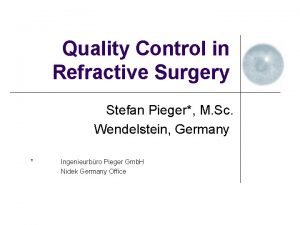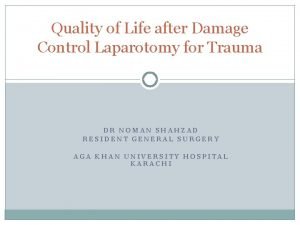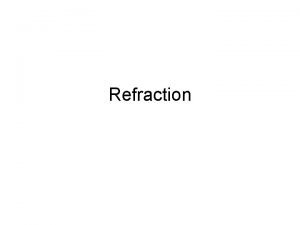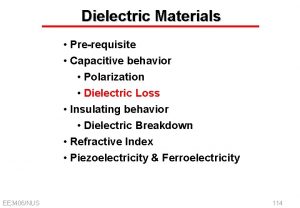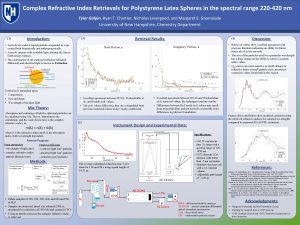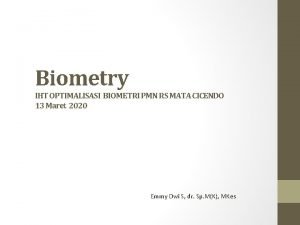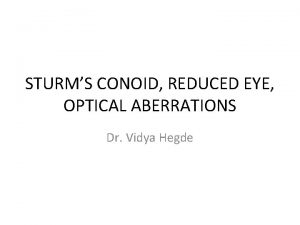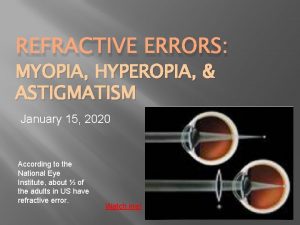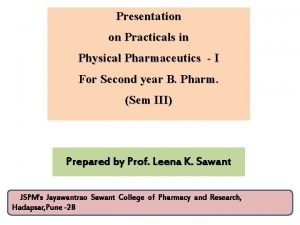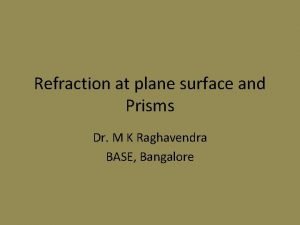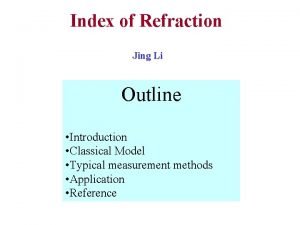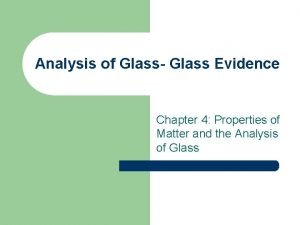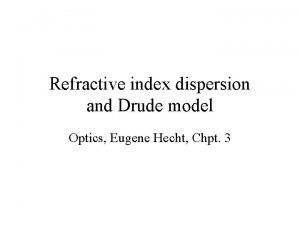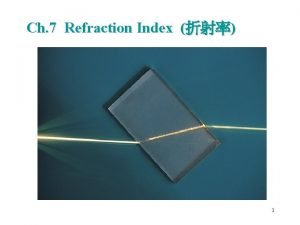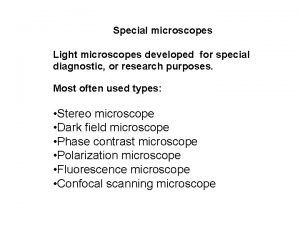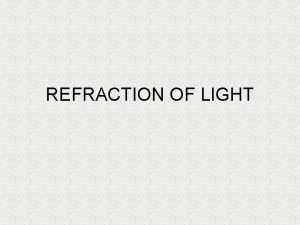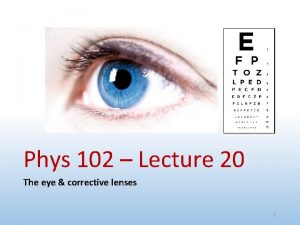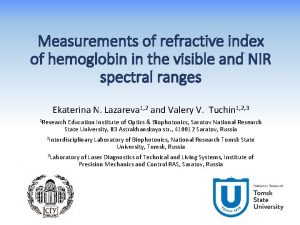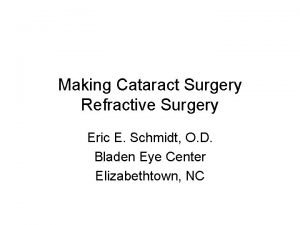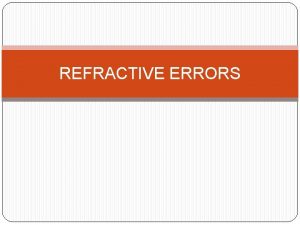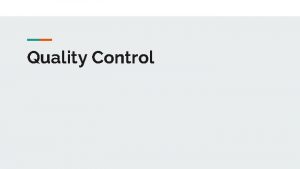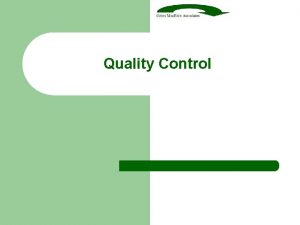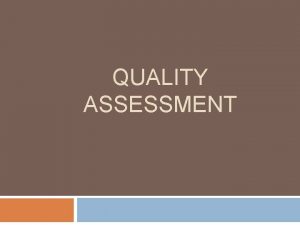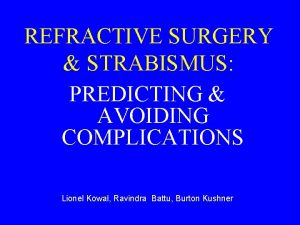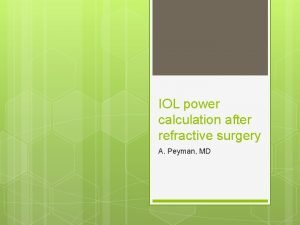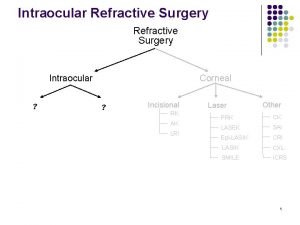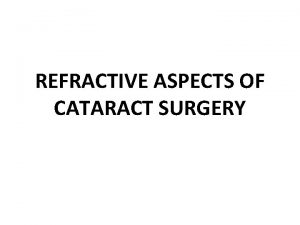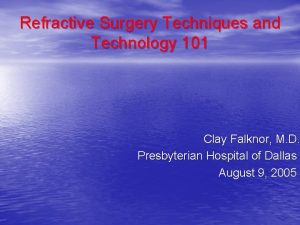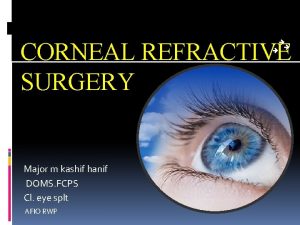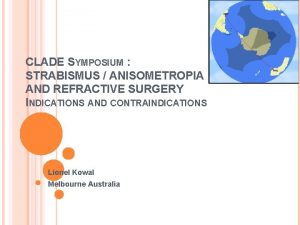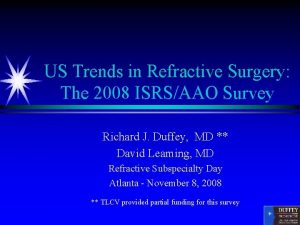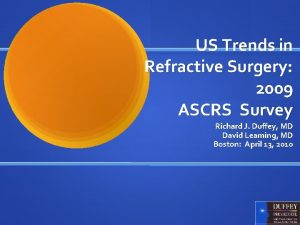Quality Control in Refractive Surgery Stefan Pieger M
















![Wavefront based Outcomes – Higher Order RMS [µm ±St. Dev] Pupil Diameter: 6. 0 Wavefront based Outcomes – Higher Order RMS [µm ±St. Dev] Pupil Diameter: 6. 0](https://slidetodoc.com/presentation_image_h2/597d60298cb654b0832ff5c0b4b00676/image-17.jpg)
![Wavefront based Outcomes – Spherical Aberration [µm] or [D] Pupil Diameter: 6. 0 mm Wavefront based Outcomes – Spherical Aberration [µm] or [D] Pupil Diameter: 6. 0 mm](https://slidetodoc.com/presentation_image_h2/597d60298cb654b0832ff5c0b4b00676/image-18.jpg)








- Slides: 26

Quality Control in Refractive Surgery Stefan Pieger*, M. Sc. Wendelstein, Germany * Ingenieurbüro Pieger Gmb. H Nidek Germany Office

Introduction l l l Personal experience as application specialist for refractive excimer lasers since 1987. (Meditec, Schwind, Nidek) Progress in PRK&LASIK was usually based on outcomes analysis. Excimer Laser Surgery and refractive surgery in general well suited for a systematic approach on quality control.

Why Quality Control? l l l Increase confidence level about refractive procedures offered in your center. Verify current nomogram settings and make adjustments if necessary. Reduce enhancement rate. Use for marketing and advertisement. Discover trends and technical problems in order to react more rapidly. Fulfill requirements of ophthalmic societies.

How to collect your data? l Patients files l Excel Spread Sheet l Database Software (Access; Filemaker; etc. ) l Outcomes Analysis Software (Datagraph; ASSORT; Refr. Consultant; etc. )

How to analyze refractive data? l Standard Refractive Outcomes l l Additional Outcome Parameters l l l Stability / Safety / Predictability / Efficacy Astigmatism Outcomes: Surgically Induced change in Cylinder (SIA); Double Angle Scatter Plot Defocus Equivalent / Contrast Sensitivity in mesopic conditions / pre OP BSCVA vs. post OP UCVA Wavefront Based Outcomes l l Defocus + Cyl (‘aberrometer refraction’) Higher Order RMS / Spherical Aberration (Z 12) / Coma / Trefoil

Standard Refractive Outcomes: Safety 2 or more lines lost 3 % at 1 m post OP Number of eyes per Follow up visit. Follow up time interval

Standard Refractive Outcomes: Efficacy 72% 20/20 or better 3 month post Op Number of eyes per Follow up visit. Follow up time interval

Standard Refractive Outcomes: Stability (SEQ) ± 1 St. Dev Follow up time interval Mean value of SEQ Number of eyes per Follow up visit.

Standard Refractive Outcomes: Predictability (SEQ) Number of eyes at follow up ± 1 D ‘happiness’ Zone Trend line y = -0. 00 x 2 + 0. 94 x + 0. 21 Regression Formula: ‘Achieved = 0. 94*Attempted’ (~6% undercorrection)

Astigmatism Outcomes: SIA (based on Vector Analysis) -2/-1@180° 0/-0. 5@90° (-0. 5/+0. 5@180°) 0. 5 D Cyl Undercorrection! Overcorrection! 0/-0. 5@180° y = 0. 90 * x (~10% undercorrection)

Astigmatism Outcomes: Double Angle Scatter Plot Pre. OP Cyl & Axis Post. OP Cyl & Axis

Additional Outcomes: pre OP BSCVA vs. post OP UCVA

Additional Outcomes: Defocus Equivalent SEQ = SPH + ½ CYL DEQ = |SEQ|+|½ CYL|

Defocus Equivalent vs. Refractive Outcome -5. 0/+10. 0@90° SEQ Plano DEQ +5 DEQ ~ ‚Blur Circle‘

Additional Outcomes: Mesopic Contrast Sensitivity Normal Population Range (Vector Vision CSV 1000) VA in Log. Mar Scale

Wavefront based Outcomes – 2 nd. Order / Coma / Trefoil l l „Work in progress“ ! Using Aberrometer Refraction rather than Manifest Refraction? Presenting horizontal and vertical Coma individually? Vector calculation to present magnitude and axis in [D]! (0. 5 D Coma @ 230°) Trefoil: Axis? Present only magnitude?
![Wavefront based Outcomes Higher Order RMS µm St Dev Pupil Diameter 6 0 Wavefront based Outcomes – Higher Order RMS [µm ±St. Dev] Pupil Diameter: 6. 0](https://slidetodoc.com/presentation_image_h2/597d60298cb654b0832ff5c0b4b00676/image-17.jpg)
Wavefront based Outcomes – Higher Order RMS [µm ±St. Dev] Pupil Diameter: 6. 0 mm
![Wavefront based Outcomes Spherical Aberration µm or D Pupil Diameter 6 0 mm Wavefront based Outcomes – Spherical Aberration [µm] or [D] Pupil Diameter: 6. 0 mm](https://slidetodoc.com/presentation_image_h2/597d60298cb654b0832ff5c0b4b00676/image-18.jpg)
Wavefront based Outcomes – Spherical Aberration [µm] or [D] Pupil Diameter: 6. 0 mm

Making Outcome-based Nomogram Adjustments l l l Comparison of Laser Settings vs. Achieved change in refraction (and not Attempted vs. Achieved). Reduce random errors as far as possible as nomograms can only compensate systematic errors! Must be specific for major laser parameters like OZ, TZ, ablation profile type as well as for refraction types.

Nomograms for Individual Patient Groups l l l Data must be filtered on certain parameters: Refraction Type (Myp/Myo. Asti/Hyp. Asti…) Surgery Type (PRK; LASIK; LASEK; Custom…) Optical Zone Diameter Others (age, laser software version; humidity…)

Nomogram Improvements – Laser Settings vs. Achieved y = -0, 01 x 2 + 1, 22 x - 0, 08 reduce attempted SEQ by 22%!

Identify and exclude outliers

Laser Setting CYL vs. Surgical Induced change in Astigmatism 1. High Scatter! (further analysis necessary!) 2. 40 % systematic undercorrection

Nomograms: General Comments 1. 2. 3. 4. 5. Reduce Scatter by Standardized Surgery and OR Environment Exclude Outliers from Data Analysis Exclude Enhancements Choose appropriate follow up interval (≥ 3 m) Create Formula („-10%“) / Lookup Table or use Nomogram Software

Summary l l Improving the results of refractive surgery procedures must be based on an individual quality control system. Nomograms can compensate for systematic errors, but not for random errors. Modern outcomes analysis software allows constant monitoring of your results. Conventional Outcomes will be extended by HO-RMS, Spherical Aberration and Coma.

Thank You! www. datagraph-med. com
 Stefan pieger
Stefan pieger Quality control and quality assurance
Quality control and quality assurance Quality management pmp
Quality management pmp Pmp gold plating
Pmp gold plating Quality assurance concepts
Quality assurance concepts Stages of damage control surgery
Stages of damage control surgery Refractive index formula
Refractive index formula Permittivity refractive index relation
Permittivity refractive index relation Refractive index polystyrene
Refractive index polystyrene Refractive surprise
Refractive surprise Alternate prism cover test
Alternate prism cover test Homocentric lens system
Homocentric lens system Refractive error diagram
Refractive error diagram What is cst method in physical pharmaceutics
What is cst method in physical pharmaceutics Negative refractive index
Negative refractive index Refraction at plane surfaces
Refraction at plane surfaces Refractive apparatus of the eye
Refractive apparatus of the eye Complex refractive index
Complex refractive index 3r rule glass
3r rule glass Drude model refractive index
Drude model refractive index Perspex refractive index
Perspex refractive index Refractive surprise
Refractive surprise Refractive index of substances
Refractive index of substances Light refractive
Light refractive Perspex refractive index
Perspex refractive index Refractive power formula
Refractive power formula Refractive index applications
Refractive index applications
